According to statistics, almost half of all appeals to a dermatologist, in one way or another, is associated with fungal diseases. You can collect the infection when you visit the swimming pool, sauna, after visiting the beach or visiting the master's slippers.
Discover everything on how to recognize the mushroom of the nail fungus on the legs without scraping and the use of other diagnostic methods: the symptoms of the manifestations of the onyicomicosis of the initial and chronic stage of the disease.
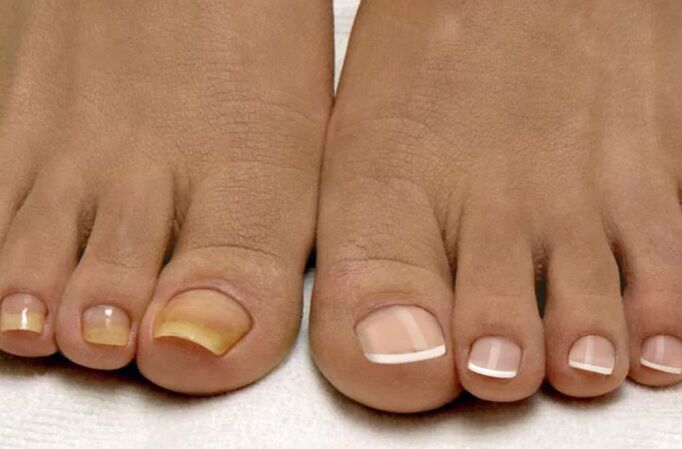
Many do not even suspect that the trivial sweating of the legs, accompanied by an unpleasant smell, which suffers more than half of the population of our planet, is one of the main symptoms of the nail fungus. This disorder is at risk of getting sick that at least a little neglecting personal hygiene.
The nail fungus is waiting everywhere, especially in places of public use. And the worst thing is that the nail fungus is a fairly insidious disease: its treatment is long and not always successful, since mycosis is included in recurrence.
To recognize the disease in time and start its treatment, you should know all the signs of the mushroom on the legs.
How does the disease spread?
The infection is caused by parasitic mushrooms. An ideal environment for their reproduction and development is an increase in humidity in combination with a hot atmosphere. It is generally accepted that the main places where the risk of nail fungus infection is high are bathrooms, saunas, aquatic parks, swimming pools, manicure salons, etc.
However, statistics completely confuse these statements: the nail fungus can be collected at home through common things (towels, shoes, clothes, carpets, shower or bathroom), if one of the family members already has this problem, or to one part, for example, through slippers, kindly proposed by the owner (and could not even suspect the presence of a disease).
But what factors influence the development of a fungal disease? There are these fundamental moments, which lead to the infection from onychomicosis:
- decrease in immunity;
- Nail plate lesion;
- violation of blood circulation in the lower ends, which can occur when wearing tight shoes;
- pathologies of the feet of anatomical nature;
- obesity;
- diabetes mellitus;
- increase in sweating.
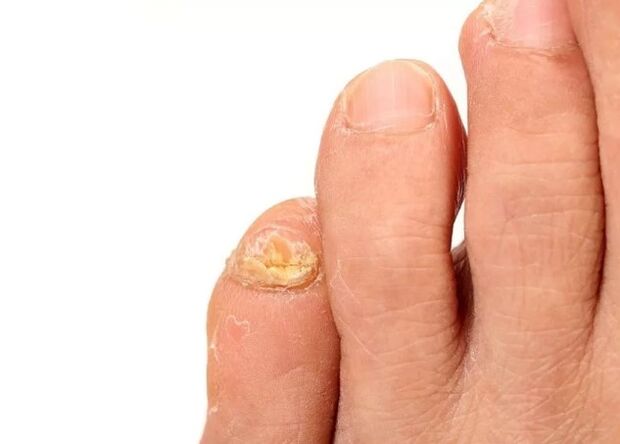
To protect yourself at least partially, you should only use your things, carefully treat the bathroom and shower with the antiseptics, use a personal towel, clean regularly and wash the rugs, disinfect the shoes. And in order not to lose the favorable moment for the treatment of mycosis (after all, everyone knows that the therapy is more effective in the initial phase of the development of the disease), it is necessary to know the first signs of the nail fungus.
Having recognized the first signs of nail mushrooms, it is necessary to immediately contact a specialist who will prescribe the optimal treatment regime.
How do different types of onychomycosis are manifested?
3 types of onychomycosis are determined, each of which manifests itself in its own signs.
You can determine the presence of a mushroom on the nails, but only a specialist can establish accurate diagnosis. To do this, you have to visit the clinic, take to analyze the scraping of a nail or a painful skin located around it. In addition, a dermatologist prescribes a microscopic or cultural study.
Signs of mushrooms by the pathogen of the disease
The success of the treatment of the nail fungus depends on how the pathogen is correctly diagnosed. This is explained by the fact that the disease does not cause a type of mushroom, but different, and each of them is sensitive to certain drugs. That is, if a type of mushroom is resistant to a drug, then the other pathogen dies from this product.
More often, the nail fungus causes:
- yeast;
- dermatophytes;
- mold.
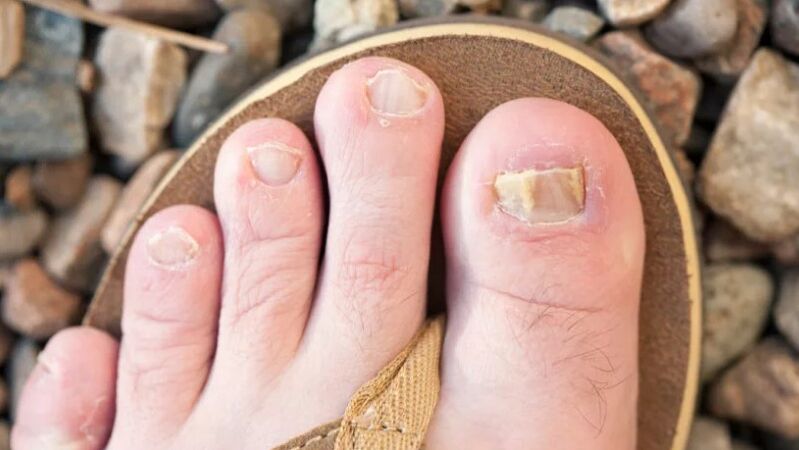
If the cause of the nail fungus became yeast, then it is almost impossible to immediately identify the disease. The signs of the mushroom on the nails of the legs in this case are the following (they appear after a long period of time): peeling of the nail plate and light itching of the skin near the nail (the itch can be absent). Bankruptcy infection occurs in 4-4, 5% of cases.
Dermatophytes affect the nails of a person much more often than the previous pathogen - this is 94, 5% of all cases of nail infection with a mushroom. Dermatophytes are of three types, each of them manifests themselves in different ways:
The last type of mushroom is mold. His pathogen is mold. This disease is found only in 1% of cases. A mushroom of this species develops more often in people with HIV infection.
Other symptoms of fungal nail infection
Often at the beginning of the disease, obvious signs of damage to fungal nails are absent. However, to be careful, you can see some changes in the structure of the nail and its appearance.
As mentioned above, longitudinal or rounded white points may appear on the nail plate, the nail can become similar to a wave, while its softness and brilliance are lost.
In progress, the disease increasingly destroys the nail plate: first its shade changes, then the surface of the nail becomes scalded, thickens or thickens, relaxes, breaks. The color of the nail depends on which type of mushroom has become the causal agent of the infection.
In addition to the main signs of onychomicosis, there are others:
- the fragility of the edges of the nail plate or all its surface;
- distortion of the shape of the nail, squamous structure of its structure;
- Blacration of the nail;
- Cut the nails under the skin;
- misconduct, sleepiness, general weakness;
- detachment of the plate from the nail bed, which leads to the formation of a plaque under the nail of a whitish or yellow shade with an unpleasant smell;
- itching, cracking, burning of the skin in the immediate vicinity of the nail concerned;
- Disbbiosis, sleepiness, general weakness.
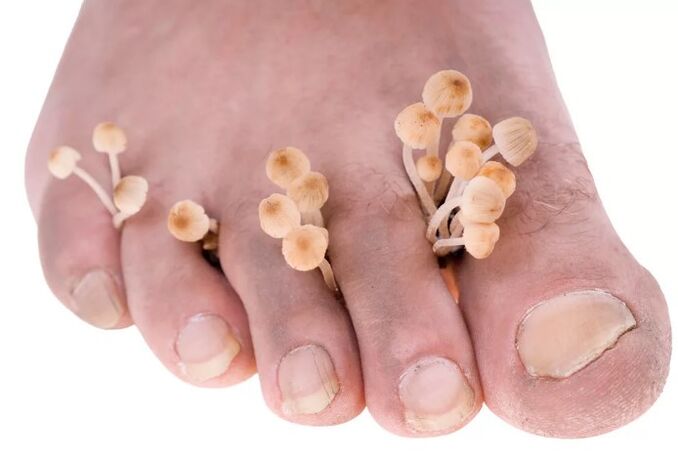
Any deviation in the appearance of the nails on the legs should be alert, as this can indicate the development of the nail fungus. The first action in this case is a journey from a dermatologist who will confirm or refute your fears. If this is not done immediately, the disease will progress.
At first glance, there is nothing wrong with this disease. However, in addition to purely aesthetic problems and discomfort, the mushroom can cause serious complications, up to the purulent infection of the affected areas and even the development of the gangrene.
Therefore, do not tighten with the treatment, take measures simultaneously, when the disease was detected.
What the nail fungus is waiting for
Every third person on Earth came across a problem such as the stratification and anger of the nails, the announcing of the plate: this is onyicomicosis. The disease affects the various age groups. The mushroom of the nails on the legs (the photos are presented below), spreads rapidly and adapts to new conditions. We will consider the main event factors, types and methods for the treatment of the mushroom in more detail.
What is the nail fungus?
Onychomycosis is a pathology that destroys nail plates. The mushroom eats keratin - the basis for the construction of the nail. The infection falls into the intercellular space and begins its division. In the advanced phases, the pathology is able to influence the skin of the feet, the intercal area, the heels.
Do not start the mushroom and treat it immediately
Causes of nail mushrooms
A onychomicosis infect is quite easy. The infection can hide on the beach, in the public soul, in the pool. A high probability of capturing a mushroom from infected relatives or acquaintances (using common lives).
There are several main prerequisites that can cause the entrance of the virus into the human body:
- A weak immune system - a decrease in protective forces due to infectious or inflammatory diseases;
- Vascular pathologies (blocking of veins) violations of the work of the internal organs (diabetes), which lead to problems with blood circulation at the lower ends;
- They give less to the skin on the feet (abrasions, microocack, seeds, corn) that occurred due to wearing tight shoes;
- ignore the skin eruption of the diaper and the intensive sweating of the lower limbs;
- Violation of caution measures: trying on someone else's role, visiting public places without slippers and abandonment of legs of the legs.

Types of nail mushrooms
Onychomycosis can cause different types of mushrooms. Dermatophytes, for example, appear in the form of cloud of the nail. There is a formation of yellow spots along the edges or in the middle of the plate. In addition, longitudinal stripes can be observed along the affected area.
In the late phases of the nail fungus, surgery may be requested
The yeast mushroom causes the deformation of the nail plate. It is very sophisticated and begins to move away from its place, it becomes grayish. The metabolism in the wound cells worsens, the furrows appear on the nail roller. In addition, inflammation, edema, redness on the adjacent epidermis is observed, the disappearance of the skin of nails is observed.
Muga bacteria can hurt the nail plate if there are already diseases that cause nail disorders for nails. In this case, there is also a cloud of the dish, a change in its color (with light yellow and greenish to brown and even black).
To discover the cause and pathogen of negative changes in the skin and nails, you need to contact a specialist. An independent determination of the disease and its treatment without consulting a doctor can be full of consequences.
Folk methods
Against fungal infection in an initial development phase, non -traditional agents can be used. The following are the most effective:
- Every day in the morning and before bedtime, until the symptoms completely disappeared, apply iodine to the nails plates affected by a mushroom;
- Mix 3 tablespoons of water with a teaspoon of glycerol, vinegar and iodine. The composition of the nails for 10 days;
- Mix the 9% vinegar with water in a proportion from 1 to 8. Dear the legs in the resulting liquid for 20 minutes. The procedures are repeated on alternate days. There should be 7-10 in total;
- Put a raw egg in the container and pour the 9%vinegar. After the complete dissolution of the shell, remove the remaining film, mix the vinegar with the egg. The solution is treated with nails infected with mushrooms twice a day for 3 weeks;
- Dissolve 4 teaspoons of hydrogen peroxide in 2 liters of water. In the container, lower your feet, keep them for 20 minutes. The course of treatment is 10 days;
- To moisten a cotton swab in peroxide, attach it to the nail, influenced by a fungal infection. Before the procedure, the legs must be steam in a bathroom with soda. At the top, the picture is wrapped with cellophane. Keep for an hour. Therapy lasts 2 weeks;
- Moisten a cotton bearing in the alcohol tincture of 20% propolis, attach to an infected nail. Keep the picture until it is completely dry. The procedure is performed twice a day. The treatment continues until the symptoms of the disease have completely disappeared;
- Clean the garlic spaggio, cut it in the floors. Wet in the salt and carefully grate the nail. Procedures to be performed twice a day until the characteristics of the mushroom have completely disappeared;
- Add 2 teaspoons of ammonia to a glass of water. In the solution, moisten a cotton, apply it on the nails affected by the mushroom, leave it during the night. The course of therapy is 7 days;
- Macing the onion thoroughly until the baby food is formed. Apply the product to plates for infected nails for half an hour. The treatment is carried out daily until complete recovery;
- Main the mint, sage and chamomile in equal proportions. Pour medicinal plants to the tip and put the night. Every day, the grass must have changed in the fresh ones. The tool is used as added to other methods;
- Take up tea tea oil and cowardice oil. To immerse them in cotton, place it on an infected nail for 45 minutes. The course of treatment is 20 days. The tool is not allowed to use during pregnancy;
- In 500 ml of water, prepare 6 teaspoons of nettle leaves. In a decoction, moisten cotton wool, place it on the plates of nails with onychomicosis. The treatment continues until the symptoms have completely disappeared.
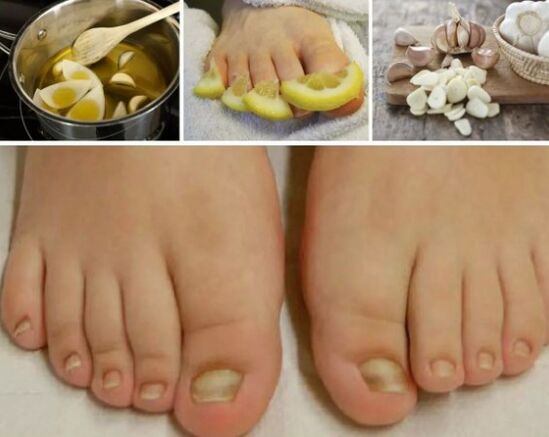
All popular remedies can only be used after consulting a dermatologist. Many of them are able to cause allergic reactions. It is easier to take care of the onychomycosis by combining non -traditional drugs with drugs.
In the initial phase, the mushroom on the legs looks like almost invisible grooves or white spots. Often a person learns to know the presence of a fungal infection only during a visit to a dermatologist. This is due to the fact that it is almost impossible to recognize the disease during this period. If you start therapy in time, the disease is quickly treated.
















